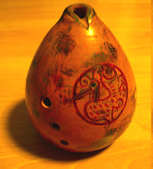
World Flutes Master
Peace web theme set courtesy of Crystal Cloud Graphics web set icon
Crystal Cloud Graphics
Crystal Cloud Graphics


Cuidemos
el Medio Ambiente
el Medio Ambiente

comprar

XUN (clay vessel flute)
The xun was said to be made of baked clay by the legendary Bao Xin Gong or by Fuxi, the first male ancestor in Chinese myth. It falls into the category of earth in the traditional bayin classifications of musical instruments based on eight kinds of materials (metal, stone, silk, bamboo, gourd, earth, hide and wood.) Of such instruments unearthed the most age-old so far, a single-finger-hole type about 7,000 years from now, was found in the site of Hemudu Village, Zhejiang province. The instruments with 1-5 ginger holes were from sites like Banbo Village (Xian, c. 5,000-3,000 BC) and some others. Xun flutes, in various periods, were in the sharp of an olive, a ball, fish or an egg, most with flattened bottoms. Its construction came to be standardized in the Shang dynasty (1766-1122 BC), generally pear-sharped with five finger holes, three at the front and two at the rear. Later types with several finger holes were melodic, mainly used in the court traditions, and by the common people as well.
Melody of China Courtesy
The xun was said to be made of baked clay by the legendary Bao Xin Gong or by Fuxi, the first male ancestor in Chinese myth. It falls into the category of earth in the traditional bayin classifications of musical instruments based on eight kinds of materials (metal, stone, silk, bamboo, gourd, earth, hide and wood.) Of such instruments unearthed the most age-old so far, a single-finger-hole type about 7,000 years from now, was found in the site of Hemudu Village, Zhejiang province. The instruments with 1-5 ginger holes were from sites like Banbo Village (Xian, c. 5,000-3,000 BC) and some others. Xun flutes, in various periods, were in the sharp of an olive, a ball, fish or an egg, most with flattened bottoms. Its construction came to be standardized in the Shang dynasty (1766-1122 BC), generally pear-sharped with five finger holes, three at the front and two at the rear. Later types with several finger holes were melodic, mainly used in the court traditions, and by the common people as well.
Melody of China Courtesy










